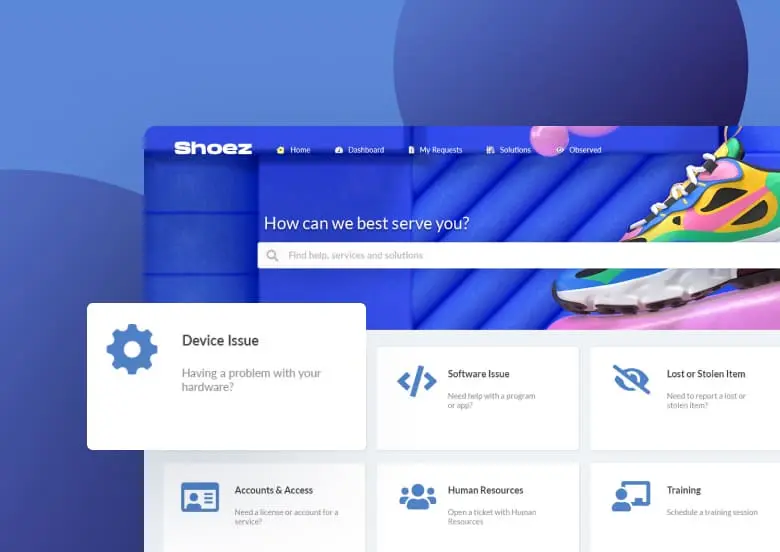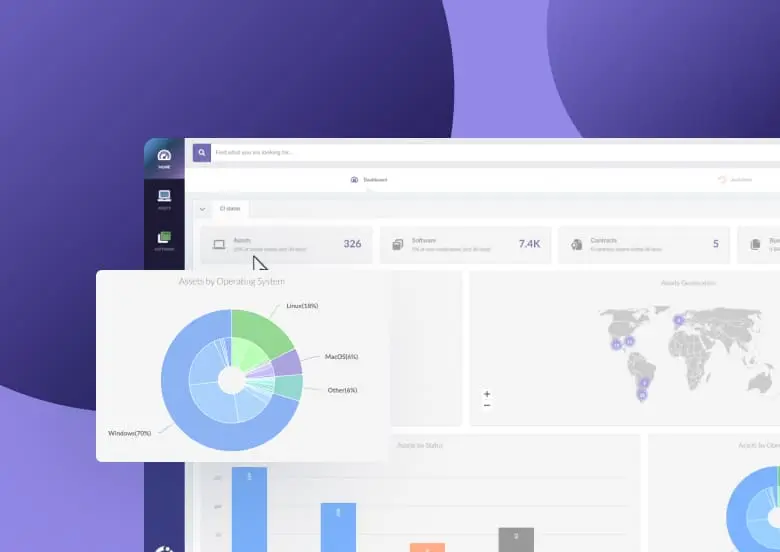Choosing an option from the many IT Service Management (ITSM) tools available is not an easy task. It usually takes months (if not years) to settle down on a solution.
We’ve spent years working with IT teams and helping organizations set up and improve their Service Management. Now, we’re sharing everything we’ve learned to help you make the best choice: what to look for, what works best in different environments, and industry trends.
If you’re choosing your first tool or considering a migration, this guide will help you make the right call.ITSM tools overview
IT Service Management (ITSM) tools provide a structured approach to managing IT services, ensuring that teams can handle incidents, service requests, and changes efficiently.
ITSM platforms connect different IT processes. They typically include a service portal for users to interact with IT, a backend system for IT staff to manage requests, and ITSM integration capabilities to connect with other business tools.
Some platforms focus on ease of use with minimal configuration, while others offer advanced customization for organizations with complex workflows.
When selecting an ITSM tool, consider the following criteria:
- Pricing model: Some tools charge a flat fee, while others use per-user or per-module pricing. Costs may increase based on add-ons, features, and integrations.
- Deployment options: Cloud-based solutions offer quick setup and automatic updates, while on-premises deployments provide greater control over security and configurations.
- Scalability and integrations: Some platforms work best for small teams, while others support large enterprises with complex IT environments. If your IT team relies on Asset Management, monitoring, or collaboration tools, check for integration options.
- Customization options: These can be a deciding factor if your organization has specific workflows. Some ITSM tools let you modify request forms, automate processes, and adjust reporting features to match internal policies.
Best 12 ITSM tools for 2025
- InvGate Service Management.
- ServiceNow ITSM.
- SolarWinds Service Desk.
- SysAid.
- Zendesk Suite.
- BMC Helix ITSM.
- FreshService.
- Jira Service Management.
- TeamDynamix.
- TOPdesk.
- SymphonyAI.
- Xurrent
These are the most important IT Management platforms in the market! In the following sections we will break them down for you.
1. InvGate Service Management
InvGate Service Management is a comprehensive ITIL-aligned ITSM solution that offers a wide range of features to help organizations streamline their IT processes.
Whether it’s on-premise or in the cloud, the tool offers a user-friendly interface and advanced automation capabilities, making it easier for IT teams to manage incidents, problems, changes, and IT service requests effectively.
InvGate Service Management also offers robust reporting and analytics features, allowing organizations to gain valuable insights into their IT operations.
InvGate Service Management features
- No-code workflow builder: Easily drag and drop components into a workflow to define its multiple steps, approvals, and more. Plus, the pre-built templates can help speed up the process even more.
- Reporting and analytics: Generate detailed reports and dashboards to gain insights into IT performance, identify areas for improvement, and demonstrate the value of IT to the business.
- Self-service portal: To empower users to resolve their own issues and request services.
- Integration with other tools and systems: Seamlessly integrate with other tools and systems used by the organization, such as IT Asset Management (it integrates natively with InvGate Asset Management), Acces Management, Communications tools, and more.
- AI-powered features: Enhances efficiency in ticket resolution and workflows.
InvGate Service Management pricing
InvGate offers flexible pricing plans that scale to meet the unique needs of your organization. You can get started with InvGate Service Management for $17 per agent per month. We also offer a free trial, so you can try our software before committing to a plan.
InvGate Service Management user reviews and ratings
- Gartner Peer Reviews score: 4.6
- G2 score: 4.6/5
It's the most thought-through ServiceDesk tool I have seen so far. It feels like somebody sat down and said "How can I make the most accessible, yet extensive, ServiceDesk tool for both agents and users."
User review from Gartner, Head of ITSM
2. ServiceNow ITSM
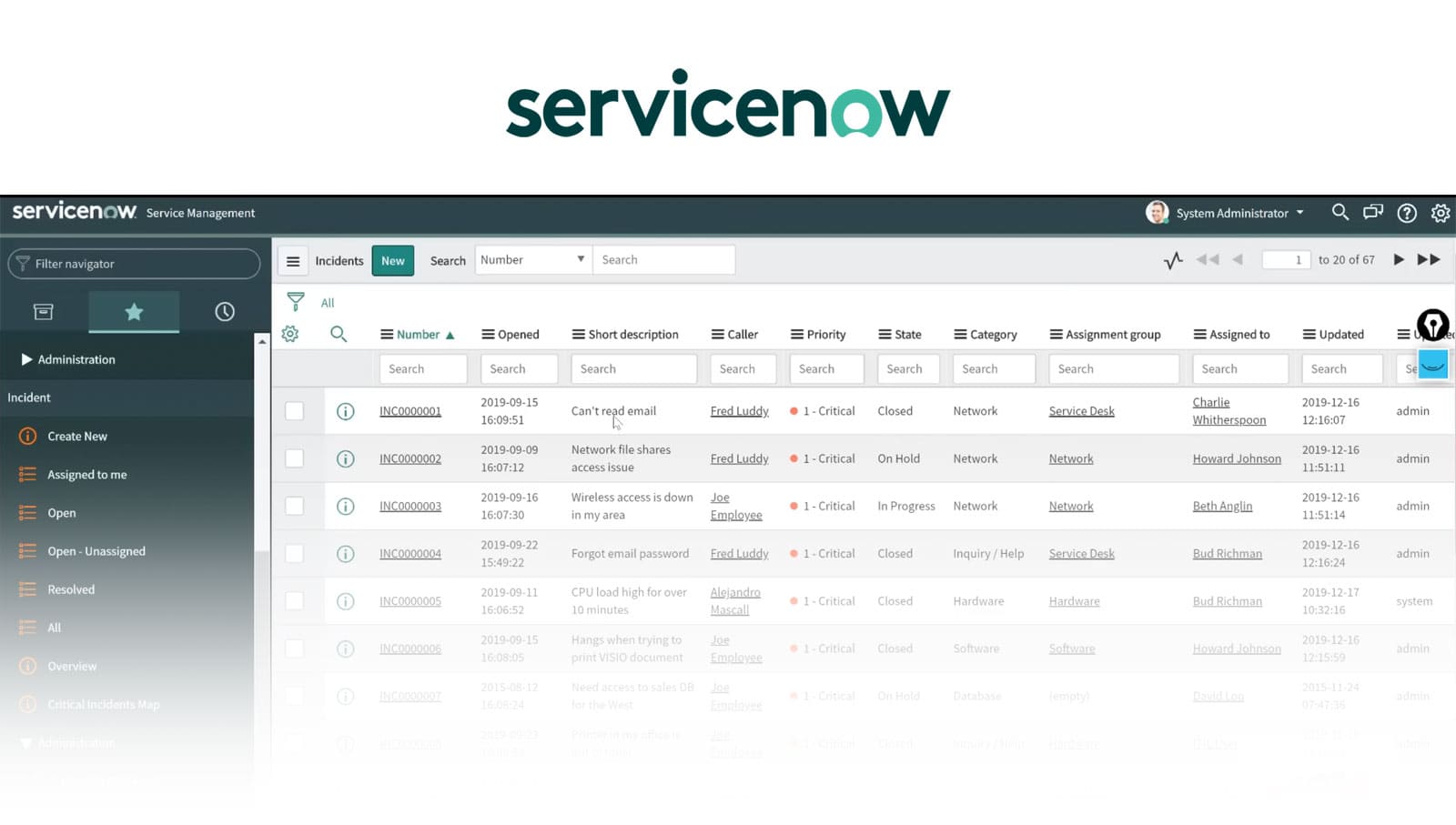
ServiceNow ITSM is one of the most widely recognized platforms used by enterprises and large organizations. Initially focused on IT Service Management (ITSM), it has since expanded into areas like HR, customer service, and security operations. Known for its scalability, it suits businesses that need a highly configurable Service Management platform.
Keep in mind that getting the platform up and running takes significant time since it has numerous modules to configure and customize. Without full commitment, the benefits may not outweigh the effort and cost.
ServiceNow features
- ITOM and ITSM integration. Expands beyond Service Management into broader IT operations.
- Low-code capabilities. Allows custom applications to be built within the platform.
- Workflow automation.
ServiceNow pros and cons
Pros:
- Highly customizable.
- Wide range of modules for different business needs.
- Scalable for enterprises.
Cons:
- Higher cost compared to other ITSM tools.
- Steep learning curve.
- Implementation can be slow.
ServiceNow pricing details
ServiceNow doesn’t disclose its pricing. We can tell you that costs depend on several factors: the chosen modules, the number of users, the type of licenses acquired, and the level of support.
ServiceNow user reviews and ratings
- Gartner Peer Reviews score: 4.8
- G2 score: 4.3
“The level of customisation is awesome and UI is very intriguing. I use this everyday to manage and get reports assigned or resolved by my team. The customisation comes with too many hurdles and we need to do more work to achieve. The cost of the tool is too high and there are few cheap alternatives also.”
User review from G2, Test Automation Analyst
3. SolarWinds Service Desk
 SolarWinds Service Desk is a cloud-based IT Service Management (ITSM) platform that adheres to ITIL best practices, offering a comprehensive suite for incident, problem, change, and release management. It is often used as part of the SolarWinds suite of IT management tools, which also includes network monitoring, database management, and IT automation solutions.
SolarWinds Service Desk is a cloud-based IT Service Management (ITSM) platform that adheres to ITIL best practices, offering a comprehensive suite for incident, problem, change, and release management. It is often used as part of the SolarWinds suite of IT management tools, which also includes network monitoring, database management, and IT automation solutions.
SolarWinds features
- Integrated IT monitoring. Connects Service Management with system performance tracking.
- Configuration Management. Automates configuration backups and changes.
- Log analysis for troubleshooting.
- Incident and Problem Management.
SolarWinds pros and cons
Pros:
- Strong focus on network management.
- User-friendly dashboards.
- Affordable compared to competitors.
Cons:
- Limited scalability for large enterprises.
- Slow loading reports.
- Security concerns in the past.
SolarWinds pricing details
There are three pricing tiers for SolarWinds Service Desk.
- Essentials: $39 per month / per technician
- Advanced: $79 per month per technician
- Premier: $99 per month / per technician
SolarWinds user reviews and ratings
- Gartner Peer Reviews score: 4.4
- G2 score: 4.3
“The integration of help desk with remote support is one of my favorite aspects. SolarWinds is really good at being our helping hand to sort out problems. (...) However, using SolarWinds to manage all devices in the network is one of the challenges we face and this may create coverage holes.”
User review from G2, System Specialist
4. SysAid
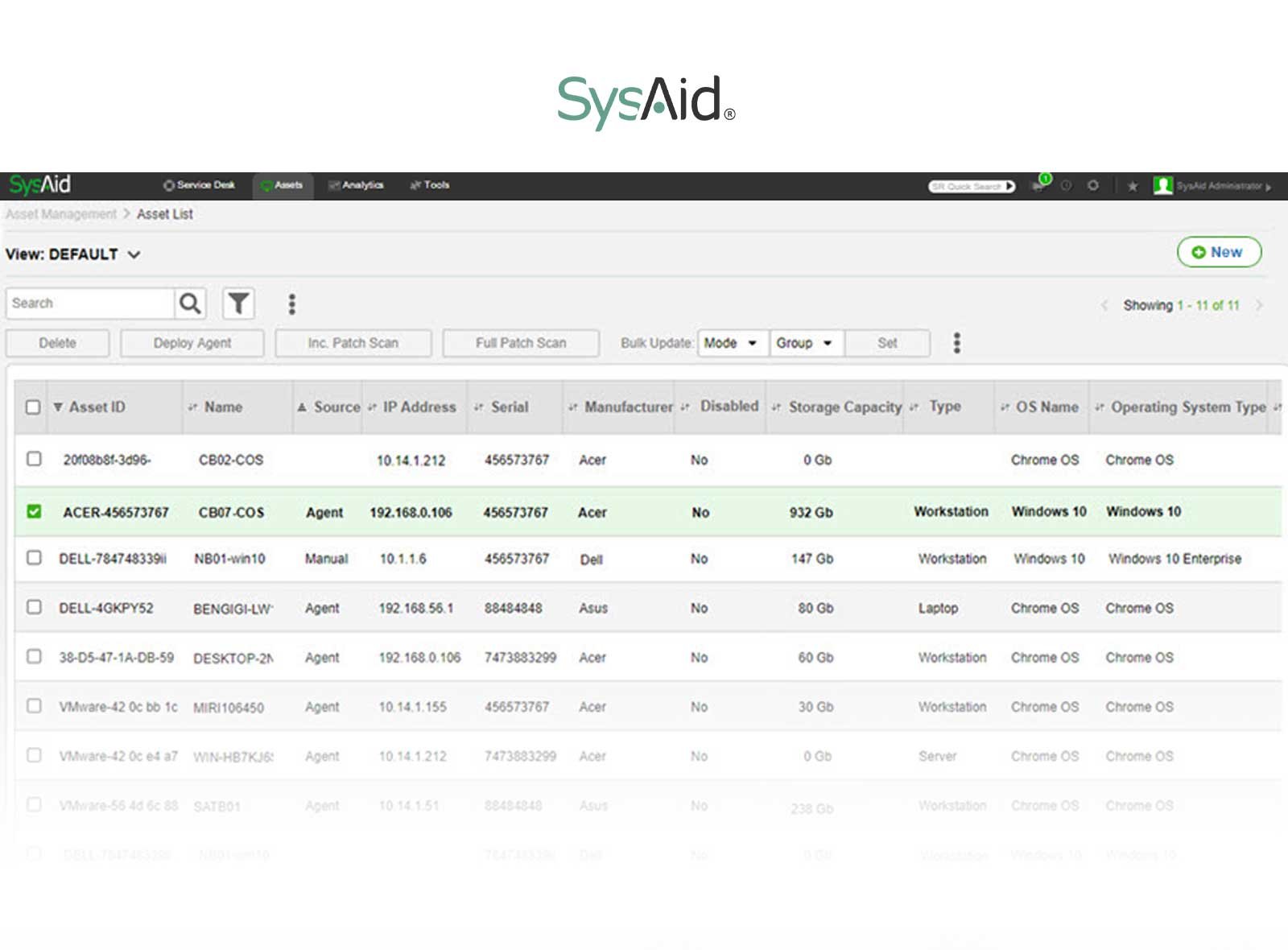 SysAid is an ITSM platform offering help desk, Asset Management, and automation tools. It is designed for small to medium-sized businesses and supports both cloud-based and on-premise deployments.
SysAid is an ITSM platform offering help desk, Asset Management, and automation tools. It is designed for small to medium-sized businesses and supports both cloud-based and on-premise deployments.
SysAid features
- Automated ticket routing with priority matrix.
- Asset Management.
- Self-service portal.
- Remote desktop access.
SysAid pros and cons
Pros:
- Easy to implement.
- Automated ticket routing.
- Strong customer support.
Cons:
- Limited advanced features compared to enterprise-grade tools.
- Less suitable for large enterprises with complex workflows.
- The interface could be more modern.
- Offers fewer features on-prem compared to cloud.
SysAid pricing details
SysAid offers tiered pricing: Help Desk, ITSM, and Enterprise. Specific pricing details are available upon request.
SysAid user reviews and ratings
- Gartner Peer Reviews score: 4.6
- G2 score: 4.5
"It is the best ITSM tool with reasonable pricing. It automatically categorizes, prioritizes and assigns tickets based on the the predefined template. Integration of SysAid with existing tools is a bit time-consuming.”
User review from Gartner, IT Manager
5. Freshservice
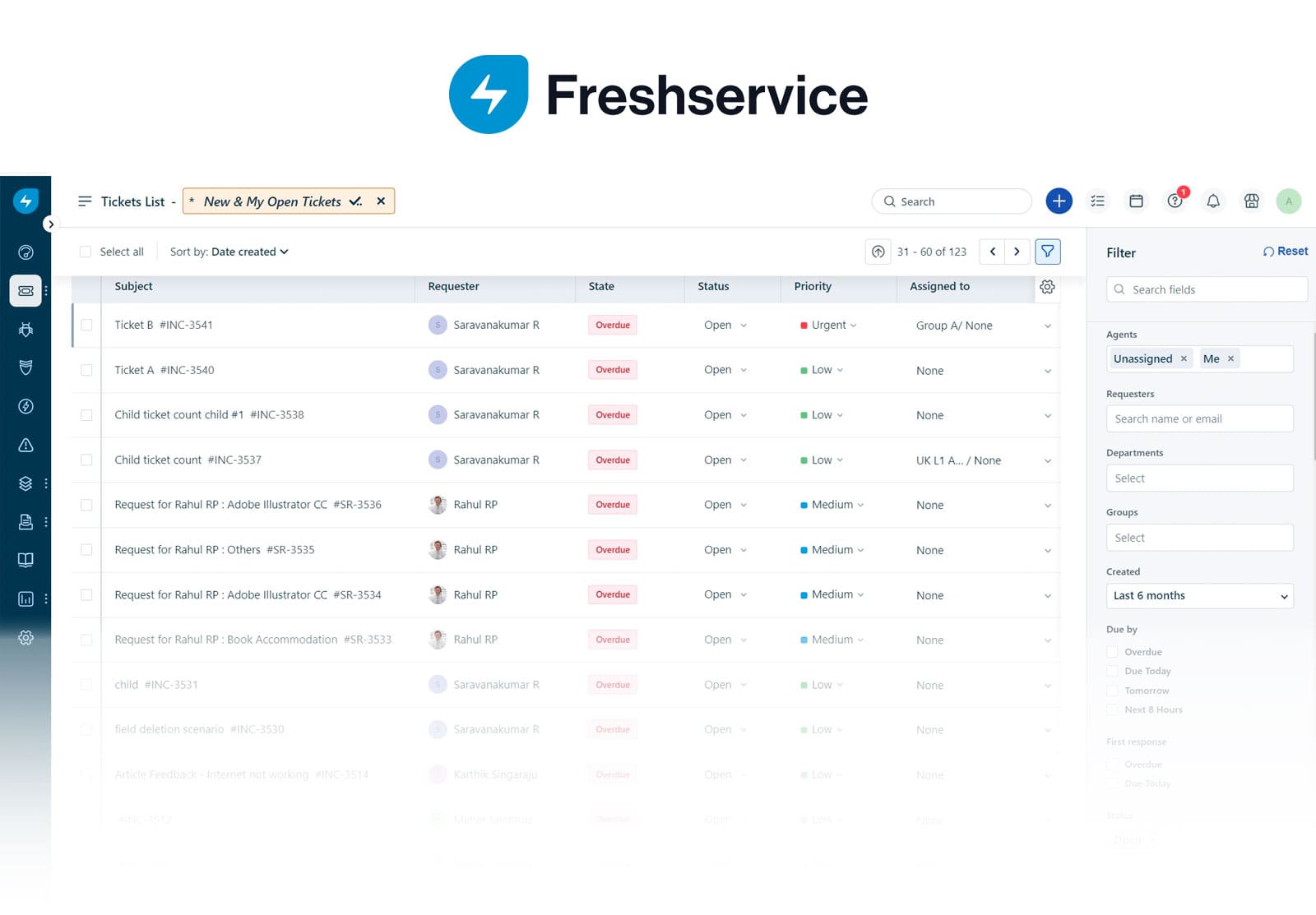
Freshservice is a cloud-based IT Service Management (ITSM) tool designed to simplify and streamline IT operations. Freshservice is known for its ease of use and scalability, making it suitable for businesses of various sizes.
Freshservice features
- Knowledge base with templates for IT documentation.
- Workload management.
- Plugin library.
- Real-time reports and analytics.
Freshservice pros and cons
Pros:
- User-friendly.
- Strong integration capabilities with existing systems.
Cons:
- Limited customization.
- For smaller teams, it is not so scalable.
Freshservice pricing details
It offers 3 subscription levels with published price, the prices with annual billing are:
- Starter: $19 per agent, per month.
- Growth: $49 per agent, per month.
- Pro: $99 per agent, per month.
The fourth tier, Enterprise, requires a quote.
Freshservice user reviews and ratings
- Gartner Peer Reviews score: 4.2
- G2 score: 4.6
"A great platform for ITSM. Now with workspaces, more company departments are working with service desks. There is a learning curve to understand freshservice, but it is very easy to use and we use it daily in our work routines. The possibility of carrying out API actions internally and externally is very versatile. Some parts of the software take longer to update, causing some problems when configuring the software.”
User review from G2, IT Manger
6. Zendesk for service
Zendesk for service is a customer service platform that also offers ITSM capabilities. It focuses on improving customer experience through ticketing systems, self-service portals, and analytics. It is entirely cloud-based and integrates well with other Zendesk products.
Zendesk features
- Omnichannel support. Centralizes requests from email, chat, and other platforms.
- Self-service tool. Includes knowledge base and community forums.
- Integration-friendly
Zendesk pros and cons
Pros:
- Intuitive interface.
- Excellent customer support features.
- Good for companies that already use Zendesk.
Cons:
- Limited IT-specific features compared to competitors because it’s centered on customer support.
- It can become costly with advanced add-ons.
Zendesk pricing details
Plans start at $49 per agent/month, with higher-tier plans offering more advanced features.
Zendesk user reviews and ratings
- Gartner Peer Reviews score: 4.4
- G2 score: 4.3
“On the whole it is a positive experience and we can handle the majority of tickets as needed, triaging effectively across the team. The support site website is OK and very easy to edit, but has limitations."
User review from Gartner, Customer Success Manager
7. BMC Helix ITSM
 BMC Helix ITSM is a well-established platform used by large organizations with complex IT operations. It supports both cloud and on-premise deployment and integrates well with other enterprise tools. Its modular design allows organizations to adopt only the components they need.
BMC Helix ITSM is a well-established platform used by large organizations with complex IT operations. It supports both cloud and on-premise deployment and integrates well with other enterprise tools. Its modular design allows organizations to adopt only the components they need.
BMC Helix ITSM features
- Multi-cloud management. Optimized for hybrid environments.
- AI-powered predictive analytics.
- Modular structure.
- Service Catalog.
BMC Helix ITSM pros and cons
Pros:
- Well-suited for large enterprises
- Strong multi-cloud support.
- Robust reporting tools.
Cons:
- High licensing and implementation costs.
- Complex setup process.
BMC Helix ITSM pricing details
Pricing is customized based on organizational needs, with quotes provided upon request.
BMC Helix user reviews and ratings
- Gartner Peer Reviews score: 4.3
- G2 score: 3.7
“It's a very powerful solution, we can do everything we want but it is not very intuitive to implement, we have to do things in many different places, it has evolved a lot since last versions, but it has a lot to improve.”
User review from Gartner, IT VP
8. Jira Service Management
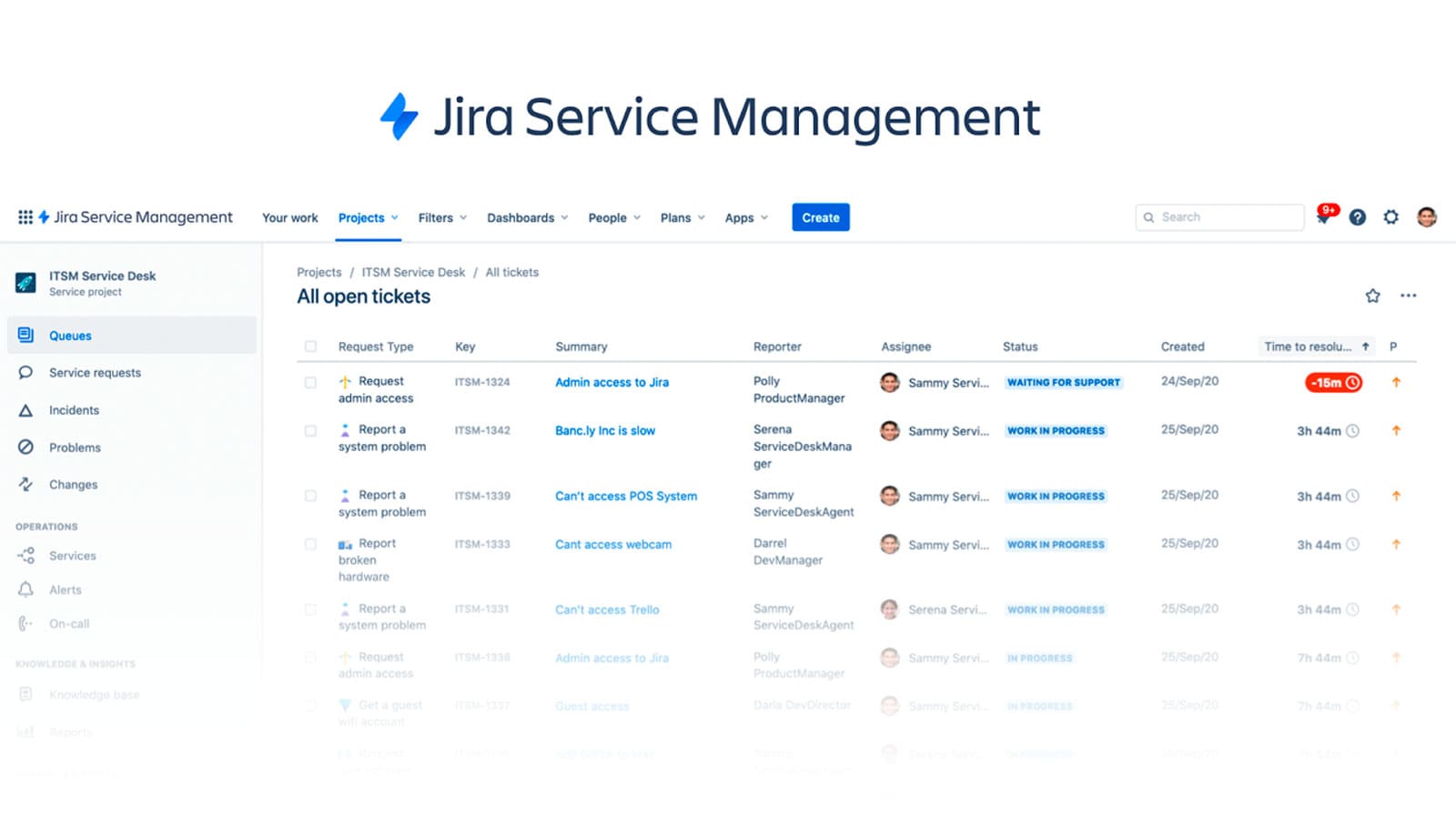 Jira Service Management by Atlassian is an agile-focused ITSM tool ideal for DevOps teams. It integrates seamlessly with other Atlassian products like Jira Software and Confluence, making it popular among software development teams.
Jira Service Management by Atlassian is an agile-focused ITSM tool ideal for DevOps teams. It integrates seamlessly with other Atlassian products like Jira Software and Confluence, making it popular among software development teams.
Jira Service Management features
- Incident tracking.
- Real-time collaboration features.
- Detailed reporting.
- Customizable workflows.
- Automation rules.
Jira Service Management pros and cons
Pros:
- Great for agile workflows.
- Affordable pricing tiers.
- Strong developer community support.
Cons:
- Requires Atlassian ecosystem familiarity.
- Higher pricing point.
- Hard for users to learn and adapt to.
Jira Service Management pricing details
It offers subscription-based plans with tiered pricing based on the number of agents.
- Free: Free for up to three agents.
- Standard: $19 per agent, per month.
- Premium: $48 per agent, per month.
Starting with 201 agents, you can contact the sales team to access the quote for the Enterprise plan.
Jira Service Management user reviews and ratings
- Gartner Peer Reviews score: 4.5
- G2 score: 4.2
“What I like most about Jira Service Management would be the possibility of being able to use the workflow designer that is included in the tool and being able to design the workflows that I need according to the area of my company. I think Jira's weak point is ease of use. It is a tool that has a fairly slow learning curve and is not as intuitive for users who are not in the Technology environment. Added to that, their IT asset manager is not that good.”
User review from G2, Account Executive
9. TeamDynamix ITSM
 TeamDynamix ITSM is a no-code, cloud-based platform that combines IT Service Management with Project Portfolio Management (PPM). It offers features like automation, AI-driven Service Management, and seamless enterprise integrations. The platform is aligned with the ITIL framework.
TeamDynamix ITSM is a no-code, cloud-based platform that combines IT Service Management with Project Portfolio Management (PPM). It offers features like automation, AI-driven Service Management, and seamless enterprise integrations. The platform is aligned with the ITIL framework.
TeamDynamix ITSM features
- Combines Service Management with project portfolio capabilities.
- No-code customization.
- Self-service portal
TeamDynamix ITSM pros and cons
Pros:
- Easy to implement and customize.
- Competitive pricing.
- Reliable and user-friendly for IT teams.
Cons:
- PPM features have a steep learning curve.
- Limited analytics compared to some competitor's advanced features.
TeamDynamix ITSM pricing details
Specific costs are available upon request.
TeamDynamix user reviews and ratings
- Gartner Peer Reviews score: 4.6
- G2 score: 4.2
"It's been a very positive experience. The vendor is responsive, the system performs well, and is flexible enough at the right price point (...) The interface is simple and easy to use. The learning curve is not as steep as other tools. It is not as fully customizable as more complex/expensive tools. Customizable forms do not permit a full range of graphic design options.”
User review from Gartner, IT Manager
10. TOPdesk ITSM
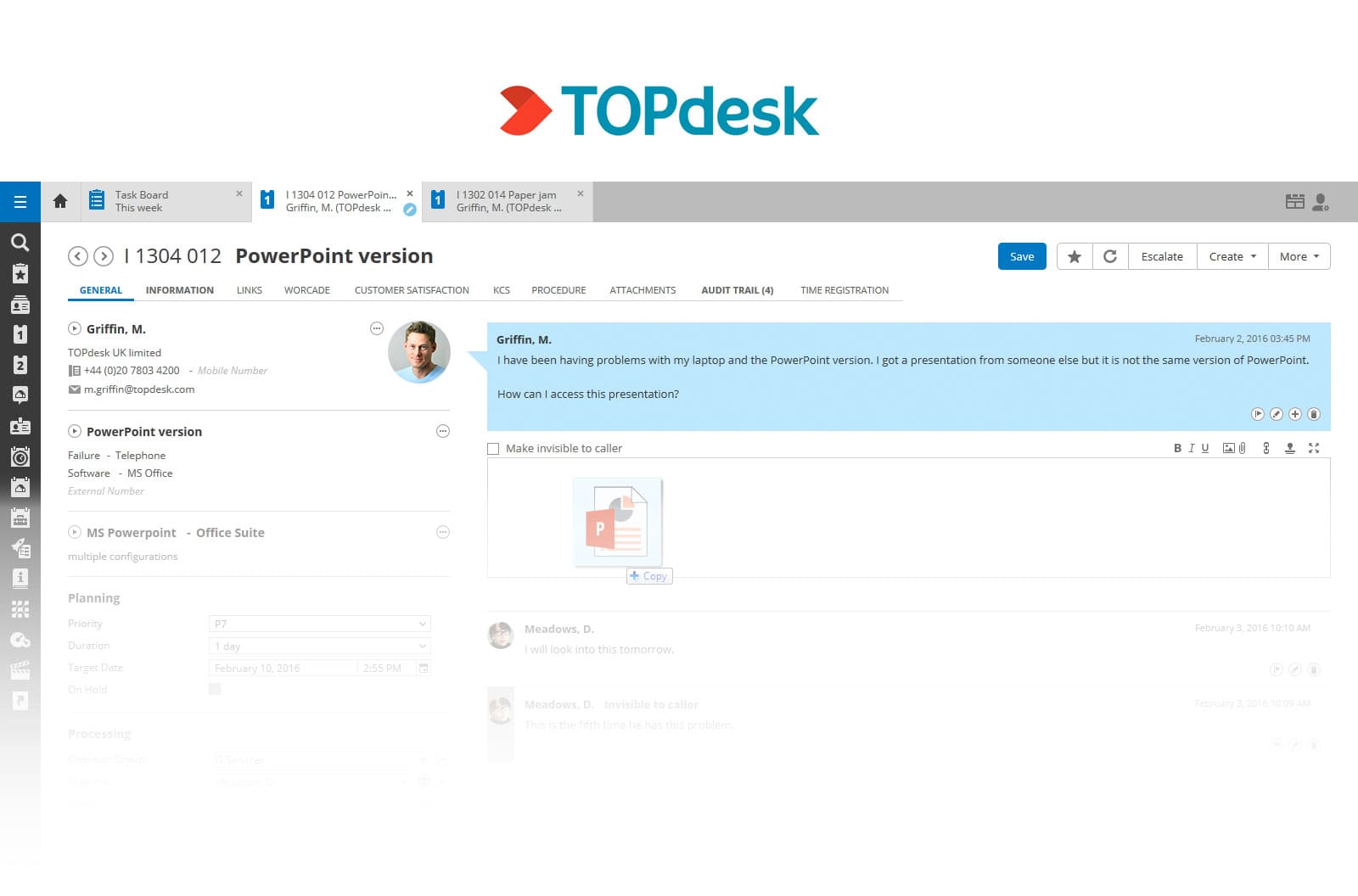 TOPdesk is an ITSM platform designed to streamline service management processes, including incident, problem, and change management. Known for its ease of use, it integrates well with popular business tools like Jira and Zendesk. It offers cloud-based deployment with flexible pricing plans.
TOPdesk is an ITSM platform designed to streamline service management processes, including incident, problem, and change management. Known for its ease of use, it integrates well with popular business tools like Jira and Zendesk. It offers cloud-based deployment with flexible pricing plans.
TOPdesk features
- Multi-channel access.
- Self-service portal.
- SLA Management
- Automated ticket routing
TOPdesk pros and cons
Pros:
- User-friendly interface.
- Strong integration options.
- Good customer support
Cons:
- No advanced reporting features in lower-tier plans.
- Pricing can increase significantly with add-ons.
TOPdesk pricing details
Pricing starts at $66 per user/month. Plans include Essential, Engaged, and Excellent tiers, offering varying levels of features such as SLA management and live chat.
TOPdesk user reviews and ratings
- Gartner Peer Reviews score: 4.5
- G2 score: 4.2
“Broad range of functionality (lots of different modules) Quick and easy to reach support desk. Limited options without additional (paid) services from external suppliers, for example, when it comes to reporting.”
User review from Gartner, IT Manager
11. SymphonyAI ITSM

SymphonyAI ITSM leverages AI to optimize IT service delivery, providing tools like automated workflows, SLA policies, and Knowledge Management. It is designed for enterprises seeking data-driven insights and process automation.
SymphonyAI ITSM features
- AI-powered workflows.
- SLA customization.
- Knowledge base.
- Advanced reporting.
SymphonyAI ITSM pros and cons
Pros:
- Strong focus on AI-driven efficiency.
- Flexible customization options.
- Comprehensive reporting tools.
Cons:
- Limited pricing transparency.
- May require training for full utilization.
- Some users report slow performance.
SymphonyAI ITSM pricing details
Pricing is not publicly disclosed; quotes are available upon request based on organizational requirements.
SymphonyAI user reviews and ratings
- Gartner Peer Reviews score: 4.4
- G2 score: 4.6
“Overall, the product is simple to use and configure. Product has improvement over the years with interface has become user friendly. End users require very less training to adapt to Symphony Service Management and thats a positive sign. Issues and custom automations take a long time to resolve. Their software support team needs drastic improvement. Speed of access also has to be improved. Slowness (of SaaS product) persists time to time.”
User review from G2, IT Manager
12. Xurrent
Xurrent is a SaaS-based IT Service Management (ITSM) platform that was rebranded from 4me™ in September 2024. It offers ITSM, IT Operations Management (ITOM), and Enterprise Service Management (ESM) capabilities, emphasizing ease of deployment, automation, and scalability.
Xurrent features
- Advanced analytics: Provides actionable insights into service performance.
- Customizable self-service portal.
- AI-powered ticketing.
Xurrent pros and cons
Pros:
- Fast response times.
- Customizability.
- Intuitive workflows.
Cons:
- Limited brand recognition compared to larger competitors.
- Advanced configurations may require additional resources.
Xurrent pricing details
Pricing details are not publicly available. Contact the vendor directly for a customized quote based on your organization’s needs.
Xurrent user reviews and ratings
- Gartner Peer Reviews score: 4.5
- G2 score: 4.6
"The learning curve is pretty minimal, easy to use. Certain features are troublesome, especially with the workflows going to the wrong person."
User review from Gartner, IT Specialist
What 7 features to look for in an ITSM tool
A well-rounded ITSM tool should offer:
- Incident and Request Management: A structured way to track, prioritize, and resolve IT issues and user requests.
- Change Management: Processes for evaluating and implementing IT changes without disrupting operations.
- Service catalog and self-service options: A user-friendly portal where employees can request IT services or find solutions independently.
- Automation and workflows: Tools to reduce manual tasks and enforce consistent processes.
- Asset Management integration: Visibility into hardware and software linked to IT services.
- Reporting and SLA tracking: Insights into IT performance and compliance with service level agreements.
- Third-party compatibility: Support for integrations with monitoring, communication, and business tools.
In conclusion
If you were given the task of researching ITSM tools, we want you to know we're here for you. We know it's hard to do, but we trust this comparison listing is a good place to start.
Do you need more help to choose the right tool for your organization? We have plenty of resources for you! Make sure to take a look at this free ITSM RFP template, a guide for you to ask all the right questions to potential vendors.
Plus, we have a great support team to guide you through the whole process! If you don't believe us, you can ask them yourself. Just schedule a call with our experts (with no strings attached).
There's only one thing we can't do for you, though. And that is actually telling you what ITSM software best suits your company. That depends on your situation, budget, needs, and staff, and you're the best judge for that.
ITSM Tools: Frequently Asked Questions
1. What is the difference between ITSM and ITIL?
ITSM refers to the overall management of IT services, while ITIL is a framework that provides best practices for ITSM.
2. How do I choose the right ITSM tool for my organization?
When choosing an ITSM tool, consider your organization's specific needs, budget, and the tool's features, pricing options, and reviews.
3. What are the benefits of using an ITSM tool?
Using an ITSM tool can provide numerous benefits, including improved IT service quality, reduced downtime, enhanced customer satisfaction, streamlined IT processes, improved compliance with industry standards, and increased efficiency and productivity.
4. How do I implement an ITSM tool in my organization?
Implementing an ITSM tool requires careful planning, training, and change management. It's important to involve stakeholders, define clear goals and objectives, and provide ongoing support and training to ensure successful adoption.
